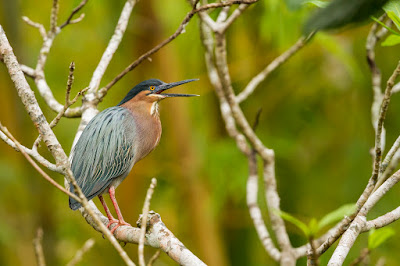Faraaz Abdool discusses how the resident birdlife of Bon Accord Lagoon signals a welcome for visiting species; making this part of Tobago a birdwatchers’ haven. (All photos courtesy Faraaz Abdool; see faraazabdool.com) First published in the Tobago Newsday, March 29, 2018
One of the most densely populated areas in Tobago holds a treasured and under-appreciated secret. In low-lying marshy southwestern Tobago, a vibrant and unique ecosystem supports all forms of life, from crabs that spend all their lives clinging to mangrove roots to birds that fly halfway around the world and back every year.
 |
| During their breeding season, heightened hormonal levels cause subtle
changes in the plumage of some species of Herons such as this Green
Heron. |
The Bon Accord Lagoon and surrounding wetlands have unfortunately been described as “barren” and in need of “development” – as if it isn’t already a complex, functioning system of critical players essential to the survival of not only the life of the wetland, but of the reefs, rivers and waterways of a sizeable portion of the island. Furthermore, there is no capital investment needed for this natural attraction to suddenly become appealing for ecotourism - already a rapidly growing sector on a global scale. Each year more and more people travel thousands of miles to enjoy natural spaces. Birdwatching in particular has skyrocketed in popularity among people of all ages and nationalities.
The Bon Accord Lagoon is known as a birding “hotspot” according to the Cornell Lab of Ornithology’s online citizen science program, eBird. A hotspot is simply a site where the bird activity is higher than average. So what makes Bon Accord a hotspot?
 |
| The Lesser Scaup swims in front of another rarity, a Grey Heron at Bon Accord two years ago |
 |
| A rare visitor: the Lesser Scaup swims in one of the ponds at Bon Accord. |
One of the most important functions of the Bon Accord Lagoon is that of a nursery. While smaller species of birds such as Bananaquits, Tanagers and Flycatchers tend to be more adaptable when it comes to choosing nest sites, larger species such as Herons and Egrets are dependent upon specific areas known as rookeries, where they communally court, mate, build nests and raise their young. Yellow-crowned Night Herons can be found throughout the island; and many of these birds were hatched right in Bon Accord. These medium-sized herons depend heavily on crabs as a food source; their thick bills make short work of the hard-shelled creatures.
Apart from serving the residents of Tobago, this wetland also performs a vital role for globe-trotting wanderers. Many species of birds migrate thousands of miles each year, from their breeding grounds in the high Arctic to the warmer tropical climates of the Caribbean and South America during the boreal winter. These birds often fly non-stop for days at a time, playing an extreme version of leapfrog with their lives at stake. Along the migration route that’s already mapped clearly in their minds are predetermined locations called stopover sites – think of these as refueling stations. At each stopover site, they eat as much as they can for the next leg of their journey. This continues until they arrive at their desired wintering ground where they spend a few weeks (or even months) after which the same process repeats itself in the opposite direction.
Extreme long-distance migrants such as shorebirds may travel from the Arctic circle to the southern tip of South America each year, but there are many other species of birds that also migrate to escape the winter cold. Various species of Warblers – tiny songbirds – often spend the entire winter within the mangrove forest at Bon Accord.
The fact that the Bon Accord Lagoon is already home to an extensive collection of local species makes it even more desirable for the migrants. It’s almost akin to reading positive reviews of hotels on the internet. If multiple species of birds can call it home on a daily basis, then migratory birds would feel much more comfortable to stop in for a while. This basic principle is what forms a magnet for one of the most coveted prizes within the realms of birdwatching: Rarities.
Rarities are species that show up on a once-in-a-blue-moon occasion. Bon Accord has proven to be an absolute haven for rare birds in the past. Just a couple years ago, a Lesser Scaup (a species of duck) was spotted swimming among the reeds – this species has appeared in Tobago only twice in the last 25 years! Visitors from across the Atlantic Ocean have also been seen here, birds like the Eurasian Wigeon usually spend their winters on the African continent, but one found itself in Bon Accord a couple years ago.
Rare birds have an indescribable appeal among birders. Many folks would readily drive a few hours, even jump on a plane to catch a glimpse of something that isn’t usually seen. In January 2017, a rare bird was spotted in someone’s backyard in the US, remaining relatively visible for approximately three months. During that time, visiting birdwatchers pumped out in excess of $220,000 US, just to catch a glimpse of this one bird.













